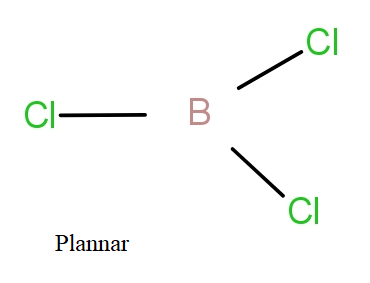Answer
424.5k+ views
Hint: Boron is electron deficient species while nitrogen is not. $BC{l_3}$ has $s{p^2}$ hybridisation with electronic configuration of boron = $1{s^2}2{s^2}2{p^1}$while $NC{l_3}$ has $s{p^3}$ hybridisation with electronic configuration of N = $1{s^2}2{s^2}2{p^3}$.
Complete answer:
To get the answer to this, we need to know about planar and pyramidal shapes.
Planar is the geometry when all atoms are in the same plane while pyramidal shape comes under tetrahedral geometry. The tetrahedral geometry involves four ligands present tetrahedrally w.r.t. the central metal atom. They have bond angle of ${109.4^0}$ between adjacent ligands.
If we see $BC{l_3}$ and $NC{l_3}$, then the Boron atom has electronic configuration as-
B = $1{s^2}2{s^2}2{p^1}$
The 2s and 2p orbital will hybridise giving $s{p^2}$ hybrid orbitals that will form bonds with chlorine atoms. The boron with $s{p^2}$ hybridisation has three bond pairs and no lone pair. So, these three bond pairs form planar structure with ${120^0}$ bond angle.
In case of $NC{l_3}$, the nitrogen atom has electronic configuration as-
N = $1{s^2}2{s^2}2{p^3}$
The 2s and 2p orbitals of nitrogen hybridise giving four $s{p^3}$ hybrid orbitals that will form bond pairs with chlorine. The nitrogen with $s{p^3}$ hybridisation has three bond pairs and one lone pair. In actuality, it has tetrahedral geometry with three sides of the tetrahedral having a bond pair and one side there is lone pair. On ignoring the lone pair, visibly the structure is of pyramid shape. Thus, named so.


So, the correct answer is “Option D”.
Note: The geometry and shape of a molecule depends upon the number of bond pairs and number of lone pairs present in the molecule. There are bond pair-bond pair repulsions, bond pair-lone pair repulsions and lone pair-lone pair repulsions which may distort the geometry giving new shapes.
Complete answer:
To get the answer to this, we need to know about planar and pyramidal shapes.
Planar is the geometry when all atoms are in the same plane while pyramidal shape comes under tetrahedral geometry. The tetrahedral geometry involves four ligands present tetrahedrally w.r.t. the central metal atom. They have bond angle of ${109.4^0}$ between adjacent ligands.
If we see $BC{l_3}$ and $NC{l_3}$, then the Boron atom has electronic configuration as-
B = $1{s^2}2{s^2}2{p^1}$
The 2s and 2p orbital will hybridise giving $s{p^2}$ hybrid orbitals that will form bonds with chlorine atoms. The boron with $s{p^2}$ hybridisation has three bond pairs and no lone pair. So, these three bond pairs form planar structure with ${120^0}$ bond angle.
In case of $NC{l_3}$, the nitrogen atom has electronic configuration as-
N = $1{s^2}2{s^2}2{p^3}$
The 2s and 2p orbitals of nitrogen hybridise giving four $s{p^3}$ hybrid orbitals that will form bond pairs with chlorine. The nitrogen with $s{p^3}$ hybridisation has three bond pairs and one lone pair. In actuality, it has tetrahedral geometry with three sides of the tetrahedral having a bond pair and one side there is lone pair. On ignoring the lone pair, visibly the structure is of pyramid shape. Thus, named so.


So, the correct answer is “Option D”.
Note: The geometry and shape of a molecule depends upon the number of bond pairs and number of lone pairs present in the molecule. There are bond pair-bond pair repulsions, bond pair-lone pair repulsions and lone pair-lone pair repulsions which may distort the geometry giving new shapes.
Recently Updated Pages
How many sigma and pi bonds are present in HCequiv class 11 chemistry CBSE

Why Are Noble Gases NonReactive class 11 chemistry CBSE

Let X and Y be the sets of all positive divisors of class 11 maths CBSE

Let x and y be 2 real numbers which satisfy the equations class 11 maths CBSE

Let x 4log 2sqrt 9k 1 + 7 and y dfrac132log 2sqrt5 class 11 maths CBSE

Let x22ax+b20 and x22bx+a20 be two equations Then the class 11 maths CBSE

Trending doubts
Fill the blanks with the suitable prepositions 1 The class 9 english CBSE

At which age domestication of animals started A Neolithic class 11 social science CBSE

Which are the Top 10 Largest Countries of the World?

Give 10 examples for herbs , shrubs , climbers , creepers

Difference between Prokaryotic cell and Eukaryotic class 11 biology CBSE

Difference Between Plant Cell and Animal Cell

Write a letter to the principal requesting him to grant class 10 english CBSE

Change the following sentences into negative and interrogative class 10 english CBSE

Fill in the blanks A 1 lakh ten thousand B 1 million class 9 maths CBSE



